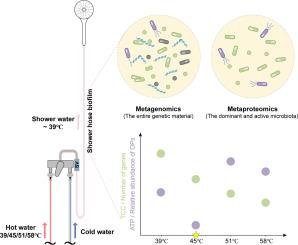Unveiling the influence of heating temperature on biofilm formation in shower hoses through multi-omics
IF 11.4
1区 环境科学与生态学
Q1 ENGINEERING, ENVIRONMENTAL
引用次数: 0
Abstract
Shower systems provide unique environments that are conducive to biofilm formation and the proliferation of pathogens. The water heating temperature is a delicate decision that can impact microbial growth, balancing safety and energy consumption. This study investigated the impact of different heating temperatures (39 °C, 45 °C, 51 °C and 58 °C) on the shower hose biofilm (exposed to a final water temperature of 39 °C) using controlled full-scale shower setups. Whole metagenome sequencing and metaproteomics were employed to unveil the microbial composition and protein expression profiles. Overall, the genes and enzymes associated with disinfectant resistance and biofilm formation appeared largely unaffected. However, metagenomic analysis revealed a sharp decline in the number of total (86,371 to 34,550) and unique genes (32,279 to 137) with the increase in hot water temperature, indicating a significant reduction of overall microbial complexity. None of the unique proteins were detected in the proteomics experiments, suggesting smaller variation among biofilms on the proteome level compared to genomic data. Furthermore, out of 43 pathogens detected by metagenomics, only 5 could actually be detected by metaproteomics. Most interestingly, our study indicates that 45 °C heating temperature may represent an optimal balance. It minimizes active biomass (ATP) and reduces the presence of pathogens while saving heating energy. Our study offered new insights into the impact of heating temperature on shower hose biofilm formation and proposed optimal parameters that ensure biosafety while conserving energy.


通过多组学揭示加热温度对淋浴软管中生物膜形成的影响
淋浴系统提供了有利于生物膜形成和病原体繁殖的独特环境。水的加热温度是一个微妙的决定,会影响微生物的生长,同时还要兼顾安全和能耗。本研究利用受控全尺寸淋浴装置,研究了不同加热温度(39°C、45°C、51°C 和 58°C)对淋浴软管生物膜(最终水温为 39°C)的影响。整个元基因组测序和元蛋白组学被用来揭示微生物组成和蛋白质表达谱。总体而言,与耐消毒剂性和生物膜形成相关的基因和酶似乎基本不受影响。不过,元基因组分析表明,随着热水温度的升高,总基因数(86 371 个降至 34 550 个)和独特基因数(32279 个降至 137 个)急剧下降,表明微生物的整体复杂性显著降低。在蛋白质组学实验中没有检测到任何独特蛋白质,这表明与基因组数据相比,生物膜在蛋白质组水平上的差异较小。此外,在元基因组学检测到的 43 种病原体中,元蛋白组学实际上只能检测到 5 种。最有趣的是,我们的研究表明 45°C 的加热温度可能是一个最佳平衡点。它能最大限度地减少活性生物质(ATP),减少病原体的存在,同时节省加热能源。我们的研究为了解加热温度对淋浴软管生物膜形成的影响提供了新的视角,并提出了既能确保生物安全又能节约能源的最佳参数。
本文章由计算机程序翻译,如有差异,请以英文原文为准。
求助全文
约1分钟内获得全文
求助全文
来源期刊

Water Research
环境科学-工程:环境
CiteScore
20.80
自引率
9.40%
发文量
1307
审稿时长
38 days
期刊介绍:
Water Research, along with its open access companion journal Water Research X, serves as a platform for publishing original research papers covering various aspects of the science and technology related to the anthropogenic water cycle, water quality, and its management worldwide. The audience targeted by the journal comprises biologists, chemical engineers, chemists, civil engineers, environmental engineers, limnologists, and microbiologists. The scope of the journal include:
•Treatment processes for water and wastewaters (municipal, agricultural, industrial, and on-site treatment), including resource recovery and residuals management;
•Urban hydrology including sewer systems, stormwater management, and green infrastructure;
•Drinking water treatment and distribution;
•Potable and non-potable water reuse;
•Sanitation, public health, and risk assessment;
•Anaerobic digestion, solid and hazardous waste management, including source characterization and the effects and control of leachates and gaseous emissions;
•Contaminants (chemical, microbial, anthropogenic particles such as nanoparticles or microplastics) and related water quality sensing, monitoring, fate, and assessment;
•Anthropogenic impacts on inland, tidal, coastal and urban waters, focusing on surface and ground waters, and point and non-point sources of pollution;
•Environmental restoration, linked to surface water, groundwater and groundwater remediation;
•Analysis of the interfaces between sediments and water, and between water and atmosphere, focusing specifically on anthropogenic impacts;
•Mathematical modelling, systems analysis, machine learning, and beneficial use of big data related to the anthropogenic water cycle;
•Socio-economic, policy, and regulations studies.
 求助内容:
求助内容: 应助结果提醒方式:
应助结果提醒方式:


